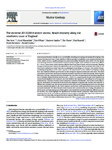The extreme 2013/2014 winter storms: Beach recovery along the southwest coast of England
| dc.contributor.author | Scott, Tim | |
| dc.contributor.author | Masselink, Gerd | |
| dc.contributor.author | O'Hare, Timothy | |
| dc.contributor.author | Saulter, A | |
| dc.contributor.author | Poate, Tim | |
| dc.contributor.author | Russell, Paul | |
| dc.contributor.author | Mikhalenko, Natalia | |
| dc.contributor.author | Conley, Daniel | |
| dc.date.accessioned | 2017-02-16T16:02:20Z | |
| dc.date.available | 2017-02-16T16:02:20Z | |
| dc.date.issued | 2016-12-01 | |
| dc.identifier.issn | 0025-3227 | |
| dc.identifier.issn | 1872-6151 | |
| dc.identifier.other | C | |
| dc.identifier.uri | http://hdl.handle.net/10026.1/8518 | |
| dc.description | publisher: Elsevier articletitle: The extreme 2013/2014 winter storms: Beach recovery along the southwest coast of England journaltitle: Marine Geology articlelink: http://dx.doi.org/10.1016/j.margeo.2016.10.011 content_type: article copyright: © 2016 The Authors. Published by Elsevier B.V. | |
| dc.description.abstract |
Sand and gravel beaches naturally act as a coastal buffer, absorbing wave energy and dynamically adapting to the seasonal and long-term wave climate. Significant shifts in nearshore morphology can occur during extreme wave events, which can have a significant impact on coastal vulnerability. During the winter of 2013/14, the Atlantic coast of Europe received an unprecedented sequence of very energetic wave conditions (8-week mean offshore Hs = 4.4 m). These events caused extensive physical (beach and dune erosion) and socio-economic (flooding, damage to infrastructure) impacts throughout the west coast of Europe. Many monitored sites in the UK and France were in their most eroded state since morphological records began (5–10 years). We consider the geomorphological significance of the storm response at 38 natural beaches in the southwest of England, ranging from semi-sheltered reflective gravel barriers to ultra-dissipative exposed sand beaches with dunes. The extent and patterns of post-storm recovery are examined in detail at three beaches with characteristic storm response behaviours. Exposed sandy beaches were dominated by cross-shore transport processes leading to significant loss of sediment offshore from the intertidal zone (> 200 m3/m); exposed gravel beaches were dominated by overwash with significant loss landward; and semi-sheltered sites exposed to more oblique wave forcing were dominated by a rotational response due to alongshore sediment redistribution. Due to these contrasting responses, mechanisms and timescales for beach recovery displayed strong inter-site and intra-site variations. In offshore and rotational cases, the recovery processes were multi-annual, comprising seasonal to decadal signals and were intrinsically linked to the storm response mechanisms, while permanent losses occurred when overwash dominated. We show that post-storm recovery does not necessarily occur during calm periods and that in many cases high-energy wave events appear to be essential for recovery of sediment (offshore and counter-rotation). Our results highlight the significance of dominant climatic oscillations, multi-annual storm sequencing, storm tracks and resultant variations in wave angle, in controlling the impact that extreme wave events have on contrasting sand/gravel beaches in exposed/sheltered locations. | |
| dc.format.extent | 224-241 | |
| dc.language | en | |
| dc.language.iso | en | |
| dc.publisher | Elsevier BV | |
| dc.subject | 13 Climate Action | |
| dc.title | The extreme 2013/2014 winter storms: Beach recovery along the southwest coast of England | |
| dc.type | journal-article | |
| dc.type | Journal Article | |
| plymouth.author-url | https://www.webofscience.com/api/gateway?GWVersion=2&SrcApp=PARTNER_APP&SrcAuth=LinksAMR&KeyUT=WOS:000390626100017&DestLinkType=FullRecord&DestApp=ALL_WOS&UsrCustomerID=11bb513d99f797142bcfeffcc58ea008 | |
| plymouth.volume | 382 | |
| plymouth.publication-status | Published | |
| plymouth.journal | Marine Geology | |
| dc.identifier.doi | 10.1016/j.margeo.2016.10.011 | |
| plymouth.organisational-group | /Plymouth | |
| plymouth.organisational-group | /Plymouth/Admin Group - REF | |
| plymouth.organisational-group | /Plymouth/Admin Group - REF/REF Admin Group - FoSE | |
| plymouth.organisational-group | /Plymouth/Faculty of Science and Engineering | |
| plymouth.organisational-group | /Plymouth/Faculty of Science and Engineering/School of Biological and Marine Sciences | |
| plymouth.organisational-group | /Plymouth/PRIMaRE Publications | |
| plymouth.organisational-group | /Plymouth/REF 2021 Researchers by UoA | |
| plymouth.organisational-group | /Plymouth/REF 2021 Researchers by UoA/UoA07 Earth Systems and Environmental Sciences | |
| plymouth.organisational-group | /Plymouth/Research Groups | |
| plymouth.organisational-group | /Plymouth/Research Groups/Marine Institute | |
| plymouth.organisational-group | /Plymouth/Users by role | |
| plymouth.organisational-group | /Plymouth/Users by role/Academics | |
| plymouth.organisational-group | /Plymouth/Users by role/Researchers in ResearchFish submission | |
| dcterms.dateAccepted | 2016-10-28 | |
| dc.identifier.eissn | 1872-6151 | |
| dc.rights.embargoperiod | Not known | |
| rioxxterms.versionofrecord | 10.1016/j.margeo.2016.10.011 | |
| rioxxterms.licenseref.uri | http://www.rioxx.net/licenses/all-rights-reserved | |
| rioxxterms.licenseref.startdate | 2016-12-01 | |
| rioxxterms.type | Journal Article/Review | |
| plymouth.funder | Physical and biological dynamic coastal processes and their role in coastal recovery (BLUE-coast)::NERC | |
| plymouth.funder | Physical and biological dynamic coastal processes and their role in coastal recovery (BLUE-coast)::NERC | |
| plymouth.oa-location | http://www.sciencedirect.com/science/article/pii/S0025322716302766?via=ihub |


